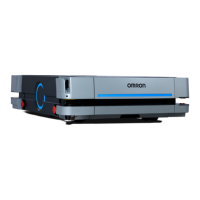43 HD-1500 Platform User's Manual 31500-000 Rev A
2.6 Environment
so that it does not attempt to drive near the hazard. Be aware that in addition to being
easily detectable, a barrier must be strong enough to resist a fully-loaded HD-1500 trav-
eling at its maximum speed.
l
Restricted Zones—These are zones of inadequate clearance which cannot be protected
by the AMR detection devices. Only authorized persons are permitted to enter. You can
use map features such as forbidden areas to keep HD-1500s within their designated
area of operation. See the Fleet Operations Workspace Core User's Manual (Cat. No. I635) for
information about editing your workspace map.
l
Operating Hazard Zones—These operating zones are areas of inadequate clearance
(less than 500 mm) between the sides of the AMR (or front/rear of the AMR) and an
obstacle such as a wall that would not leave sufficient room for a person to escape and
avoid getting crushed between the AMR and the obstacle. It can also be an area which
cannot be protected by the AMR detection devices. These areas shall be clearly indicated
by suitable signs or preferably floor markings. In this operating hazard zone, the AMR
speed shall be in accordance with ISO 3691-4, and shall emit additional audible or
visual warnings.
l
Confined Zones—These are zones of inadequate clearance, and where the AMR detec-
tion devices may be omitted, at any speed. The confined zones shall be marked, and be
enclosed with fixed guards that are at least 2.1 m high.
l
Load Transfer Stations—These are the designated locations for load transfer. When the
load transfer stations are outside the restricted or confined zones, these stations shall be
designed to prevent personal injury by the rigid parts of the AMR or its payload. These
load transfer stations shall be designated as operating hazard zones as defined in this
section of the manual.
Although the HD-1500's software provides the option of using the map features to keep the
HD-1500 within its designated workspace, you must always install physical barriers where
there is a risk of property damage or personal hazard.
Public Access
The HD-1500 is designed to operate in indoor industrial environments, and in presence of
trained personnel. You must deploy it only in applications where you anticipate and mitigate
potential risks to personnel and equipment.
OMRON intends for the HD-1500 to be used in controlled areas for which a risk assessment
has been conducted. OMRON does not intend the HD-1500 to be used in, for example, areas
open to general public access.
Operating Clearances
This section provides information regarding the side clearances, rotation clearances, and the
docking clearances when operating.
Side Clearances
The HD-1500 is designed to operate in environments that contain doors, passageways, or other
constrained areas that are wide enough for it to traverse.
However, you must maintain adequate side clearance (free space) on both sides of the AMR so
that it cannot trap a person against a wall or other fixed object. Consult the applicable
Autonomous Vehicle and Robotics operating standards for your locale.

